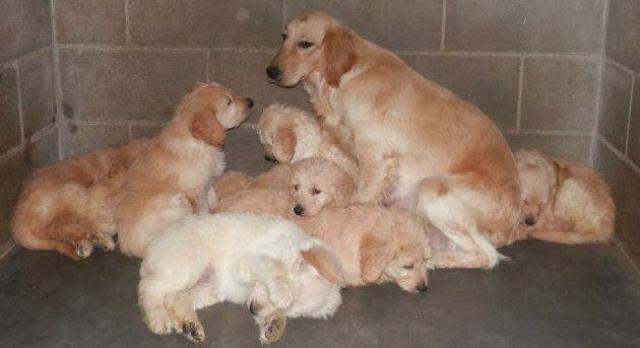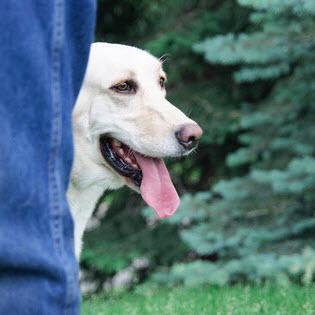Many dogs come to RAGOM from commercial breeding facilities—businesses focused on the production and sale of puppies. These dogs have experienced life very differently from other dogs.
A Scary New World
Most dogs from these facilities have endured psychological stress throughout their lives and have never been socialized or exposed to the normal things a family dog experiences every day.
So initially, navigating life in your home is fraught with many scary experiences. These dogs are fearful of doorways, stairs, televisions, loud noises, hardwood floors, and even the sound of the washing machine. All dogs from these facilities exhibit some level of fear; the severity depends on their personalities and past experiences.
While some respond quickly to a nurturing home environment, others require months or years of rehabilitation. The goal is to lessen their fear so they become comfortable with humans and basic activities such as going through doorways, playing with toys, riding in cars, getting bathed, going up and down stairs, and hearing a vacuum cleaner.
Safety First
Most importantly, they must be kept safe while they adjust to their new life both indoors and outdoors. Therefore, RAGOM strongly advises that the dog initially be kept on a long lead while outdoors, even within the confines of a physical fence.
Because these dogs are often fearful of people and any new noise, they might run when frightened. Chasing them will scare them even more. A long lead provides a way to carefully guide them back.
Due to their fear of unexpected and unfamiliar stimuli and noises—and their inability to recover from this fear as quickly as other dogs—RAGOM does not allow the use of invisible fences as a means of containment. The beep or vibration used in training to help the dog learn boundaries can terrify the dog.
This can lead to the dog not wanting to go outside. Worse, it can cause the dog to run in fear—right through the shock emitted by the invisible fence, leading to further trauma and terror.
The Importance of a Role Model
The single most important factor in rehabilitating these dogs is a role model: a confident household dog who is social with humans and other dogs to help the former breeding dog navigate and become accustomed to their new world.
For evidence-based research that supports this RAGOM requirement, read Some Rescued Dogs Need a Role Model to Thrive.
Keys to Success
Keys to success in rehabilitating a former commercial breeding dog:
- Another social, confident medium- to large-sized dog in the household.
- A home with children 10 years of age or older, or no children in the home. Younger children can be noisy and unpredictable, which is stressful for a fearful dog. This RAGOM requirement is enforced not only in the best interest for the dog, but for safety reasons as well.
- Provide a "safe spot" for the dog, such as a crate or enclosed area where he can retreat if overwhelmed. Placing the safe spot where the family is often present lets him observe family life without feeling stressed.
- Keep the dog on a leash at all times initially; allowing free roam of your entire home is overwhelming. He has not yet learned that humans can be safe and friendly, so he will most likely run if approached and will not come when called. Loud unexpected noises can startle and cause him to flee.
- Set a routine. Despite coming from a less than ideal environment, it is the only life he knows. So although you know he is safe now, he is confused and terrified of this new way of life. Knowing what to expect will help your dog feel safe. Feed at the same time every day, schedule potty breaks and walks, and be consistent about household rules.
- Be patient and proceed slowly. Do not force your dog to accept your touch. Let him come to you when he is ready. Slowly introduce only a few new experiences at a time.
Retired Breeding Dog Resources
Getting Help with a Dog from a Puppy Mill
Rehabilitating Your Rescued Dog Action Kit



